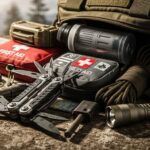Nature’s fury can strike suddenly and without warning. Among the most dangerous disasters are flash floods, avalanches, and landslides — fast-moving, overwhelming forces that can sweep away even the strongest person. The key to survival is not just strength, but awareness, preparation, and split-second decision-making.
Let’s break down survival tactics for each of these deadly scenarios.
🌊 Flash Flood Survival
Flash floods occur when heavy rains or sudden dam breaks unleash torrents of water with incredible force.
How to Survive:
- Get to High Ground Immediately – Don’t wait. Even a few inches of fast-moving water can knock you down.
- Avoid Roads & Bridges – Floodwaters can sweep vehicles away and collapse weak bridges.
- Don’t Try to Swim – Instead, grab floating objects or climb to safety. Swimming in flood currents will exhaust you quickly.
- Know the Signs – Intense rainfall, roaring water sounds, or debris flow upstream are red flags.
❄️ Avalanche Survival
Avalanches can bury entire areas in seconds, trapping victims under snow and ice.
How to Survive:
- Move Sideways – Avalanches flow down slopes like rivers; move toward the edges.
- Jettison Gear – Drop heavy packs to move faster, but keep survival essentials if possible.
- Create an Air Pocket – Cup your hands over your mouth and nose if you’re being buried. This can buy precious oxygen.
- “Swim” Motion – Flail and swim hard to stay near the surface.
- After Burial – If trapped, stay calm, conserve oxygen, and try to determine which way is up (spit may fall downward).

🪨 Landslide Survival
Landslides often follow heavy rains, earthquakes, or volcanic activity, sending soil and rock crashing down slopes.
How to Survive:
- Move Perpendicular to the Slide – Don’t run downhill with it; escape sideways to safer ground.
- Protect Your Head – Falling rocks and debris cause most injuries. Use your arms, backpack, or jacket as a shield.
- Avoid Valleys & Riverbeds – These funnel landslides into even more destructive channels.
- Aftermath – Stay alert. Secondary slides often follow the first wave.
General Rules for All Three
- Awareness Saves Lives – Always check weather forecasts, avalanche reports, and terrain conditions before venturing out.
- Trust Your Instincts – Strange roaring sounds, cracking snow, or trembling ground are signs to move immediately.
- Never Underestimate Nature – Speed matters more than gear in these emergencies.
Final Thoughts
Whether it’s a wall of water, snow, or earth, survival depends on rapid decision-making and smart tactics. The best defense is always preparation — learn the warning signs, practice escape routes, and never ignore nature’s signals.
Because in these disasters, seconds aren’t just important — they’re everything.

















